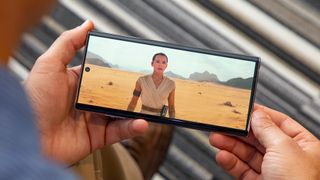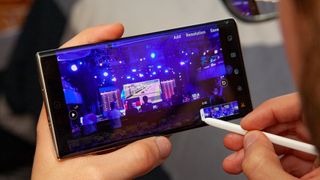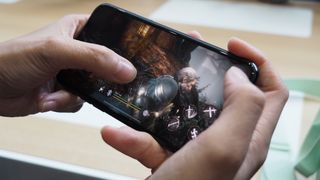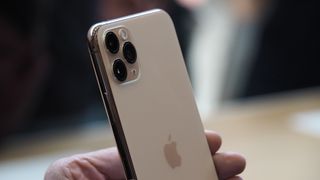
https://www.cnet.com/news/iphone-11-pro-max-specs-vs-iphone-xr-xs-max-specs-whats-new-different-apple-price/
2019-09-11 12:16:21Z
52780378330583

Pixel 4 leaks just won't stop. Over the last couple of days, we've seen a multitude of photos and videos showing the phone in the wild, giving us a good idea of what it looks like and which hardware is built in. Another leak courtesy of YouTuber Brandon Lee offers us a glimpse at some hands-free gestures coming to the Pixel 4 thanks to radar-based Soli technology. Following him, Evleaks published a high-quality render of the phone's front with an October 15 date on it, suggesting it might launch that day.
Evan Blass took his Twitter account private a while ago, so a screenshot must suffice.
Evleaks' image is likely coming via a screen protector manufacturer. The most interesting tidbit is the October 15 date shown on the display. Google has historically announced new hardware on Tuesdays, and although October 15 seems a little late compared to previous Pixel events, leaked Pixel 3 screens also showed their respective launch dates, so it's highly likely the fourth iteration will be unveiled then.
Additionally, radar hardware has been in the works at Google for years in the form of Project Soli. The company apparently feels confident enough that it will ship the Pixel 4 with it. While Google's early prototypes allowed for extremely delicate gestures, the flagship supports more broad movements that are easier to recognize and remember. Lee's video offers us some insight into them. They'll be collected under the "Motion Sense" section in the Pixel 4's settings. To get a better sense of the gestures, take a look at the video below.
Just as we've seen in Google's official Pixel 4 video, you can skip songs by waving to the right in front of the phone. To listen to the previous title, you move your hand to the left. In Motion Sense's settings, you can choose to invert these gestures if that's more comfortable for you.
Should you want to silence the phone when an alarm goes off or when someone calls you, you can wave a dismissive gesture in front of the screen similar to the ones for skipping songs, but Brandon says you can also achieve that by "swatting at it like a cat."
To see the lock screen, notifications, and time while the Pixel 4 lays flat on a table, you can hover over it with your hand to activate the display. Additionally, the phone can recognize when you're near it and only turns on Ambient Screen when that's the case. It's unclear if there's a security check involved – maybe it verifies your identity through face unlock before activating the display.
There's a disclaimer within the settings reassuring users that Google doesn't use the camera, the mic, or location to sense your proximity. That's an improvement over similar features from other manufacturers like LG or third-party apps that rely on the front camera to achieve air-gesture functionality. All of these gestures can be toggled on and off individually, just as Motion Sense can be turned off altogether, too.
Unfortunately, an earlier Best Buy leak suggests that Motion Sense won't be available everywhere, probably due to regulatory issues surrounding radar technology. Japan is known to be excluded, while Best Buy says that the feature works "in the US, Canada, Singapore, Australia, Taiwan, and most European countries."
If you look at the specs and feature list for the iPhone 11 Pro, things don’t look pretty for Samsung’s Galaxy Note 10 flagship. Apple’s new smartphone has the most powerful processor ever in a phone, much improved cameras and up to 5 hours longer battery life over last year’s iPhone. But it’s not game-over for the new Note — not by a longshot.
Here are five ways the Galaxy Note 10 beats the iPhone 11, and four ways Apple looks to still be on top.
Where Samsung wins...

(Image credit: Future)
Yes, the iPhone 11 Pro’s new Super Retina XDR displays are brighter and more colorful than anything Apple has ever built, but if you simply prefer a larger panel, the Galaxy Note 10 beats the iPhone 11 Pro. The regular Galaxy Note 10 has a 6.1-inch AMOLED screen and the Note 10 Plus sports a huge 6.8-inch display. Meanwhile, the iPhone 11 makes do with a 5.8-inch screen and the iPhone 11 Pro Max maxes out at 6.5 inches.
How does quadruple the storage sound to you? Both the Galaxy Note 10 and Galaxy Note 10 Plus come with 256GB of storage standard. Bad news: the iPhone 11 Pro and 11 Pro Max start with a measly 64GB of storage. I can see why Apple might stick its regular $699 iPhone 11 64GB, but not a $1,000 flagship (let alone a $1,100 one). Plus, the Galaxy Note 10 Plus offers microSD expansion, something Apple’s iPhones never have included.

(Image credit: Future)
Although the iPhone 11 Pro was rumored to add Apple Pencil support, it just didn’t happen. The Galaxy Note 10 and Note 10 Plus both offer Samsung’s S Pen, which lets you take notes and draw with ease. And both Note 10 devices support new S Pen capabilities, including Air Gestures for things like switching camera modes with a wave of your hand and converting handwriting to text.
Another rumored iPhone 11 Pro feature that didn’t come to pass is reverse wireless charging, which would have allowed you to place Qi-compatible devices like AirPods on the back of the phones to give them some juice. The Galaxy Note 10 and Note 10 Plus both have reverse wireless charging, allowing you to not only top off your Galaxy Buds but also other smartphones that support the Qi wireless charging standard — such as the iPhone 11 Pro that Apple just introduced.
If you’re willing to spend $1,299, you can get a Galaxy Note 10 Plus 5G from Verizon (with the phone coming to other carriers soon). And with that wireless boost you can enjoy gigabit speeds in a growing number of cities where 5G networks are deployed. Granted, it’s going to take a while to get to nationwide coverage, but if you live in an area with 5G you can enjoy up to 10 times faster download speeds. And that’s something you won’t get from an iPhone until 2020 at the earliest.
Where Apple Wins...

(Image credit: Future)
Just when you thought Qualcomm’s Snapdragon 855 processor was catching up — or at least closing the performance gap — with Apple’s phones, along comes the A13 Bionic. Apple’s new processor promises 20 percent faster CPU and graphics performance than the already-blazing A12 chip. This chip also boasts a faster neural engine for real-time photo and video analysis, resulting in better looking pics and clips. And the A13 processor will shine on console-quality games like Pascal’s Wager, coming to the iPhone this fall.

(Image credit: Tom's Guide)
The Galaxy Note 10 and Note 10 Pro have very capable triple rear camera systems that impressed us in our testing, but they still fell behind Google in our Note 10 vs Pixel 3 camera face-off. And it looks like the iPhone 11 Pro and 11 Pro Max could easily move to the front of the back based on Apple’s improvements
We’re talking about dramatically better low-light performance with a new Night Mode that you don’t have to manually engage, an ultra-wide camera that gives you a live preview of what you could be missing while you’re shooting and the ability to take portraits using either the wide-angle or ultra-wide lens. And the improved Smart HDR mode should reveal details in challenging lighting conditions that the Note 10 can’t muster.
The Galaxy Note 10 and Note 10 Plus held their own in our battery testing, but Apple is promising a huge boost in endurance for the iPhone 11 Pro and iPhone 11 Pro Max. The company says to expect 4 more hours of runtime out of the iPhone 11 Pro and 5 hours of more saying power for the 11 Pro Max. We’ll have to see how long Apple’s new handsets last on our web surfing test to see if these flagships crack our best phone battery life list.

(Image credit: Apple)
Samsung continues to trail Apple is its services and content ecosystem. With Apple Arcade, launching Sept. 19, you can play 100 exclusive iOS titles that you won’t find on the Note 10 (or any Android phone) for one reasonable $4.99 monthly price. Launching Nov. 1, Apple TV+ is an even better deal in that Apple is giving away this $4.99 monthly service for free with any new iPhone you buy. So that means you’ll get access to Jason Momoa’s See, The Morning Show with Jennifer Aniston and Steve Carell and more for nothing (to start).
Once we’ve had a chance to review the iPhone 11 Pro and 11 Pro Max, we will do a proper face-off between Apple’s ultra-premium handsets and the Galaxy Note 10 and Note 10 Plus. But overall there’s still plenty of reasons to consider Samsung’s phablets. It all comes down to what you value most in a flagship phone.